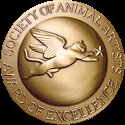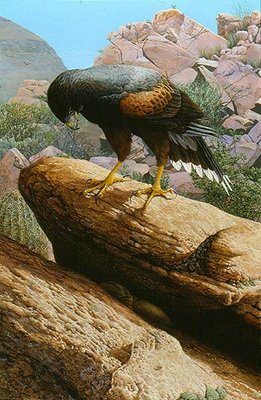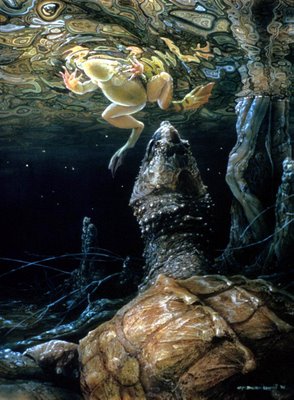A BIT OF BRAGGADOCIO
 I hate to boast...well, that's not exactly true, but I do think it's usually inappropriate...even so, I'm going to make an exception just this once. My friends Wes and Rachelle Siegrist attended last Friday's opening of Art & the Animal at the Bennington Center for the Arts in Vermont. A&TA is the big annual member's exhibition of the Society of Animal Artists. Wes emailed me yesterday to let me know that my painting Harris' Hawk & Chuckwalla was awarded the Society's highest honor, the Award of Excellence. So to celebrate, I'll post this shameless little gallery of my five paintings that have received Awards of Excellence from the society: (UPDATE: the other recipients of this year's Award of Excellence are: Robert Bateman, Willem de Beer, Carrie Gantt Quade, Patricia Jackman, Jan Martin McGuire, Matthew Gray Palmer, Louise Peterson, John Pitcher, Ken Rowe, John Seerey-Lester and W. Leon White.)
I hate to boast...well, that's not exactly true, but I do think it's usually inappropriate...even so, I'm going to make an exception just this once. My friends Wes and Rachelle Siegrist attended last Friday's opening of Art & the Animal at the Bennington Center for the Arts in Vermont. A&TA is the big annual member's exhibition of the Society of Animal Artists. Wes emailed me yesterday to let me know that my painting Harris' Hawk & Chuckwalla was awarded the Society's highest honor, the Award of Excellence. So to celebrate, I'll post this shameless little gallery of my five paintings that have received Awards of Excellence from the society: (UPDATE: the other recipients of this year's Award of Excellence are: Robert Bateman, Willem de Beer, Carrie Gantt Quade, Patricia Jackman, Jan Martin McGuire, Matthew Gray Palmer, Louise Peterson, John Pitcher, Ken Rowe, John Seerey-Lester and W. Leon White.)
2006: HARRIS' HAWK & CHUCKWALLA
Harris' Hawk (Parabuteo unicinctus) is a unique raptor species of the American tropics. Normally shunning thick jungles, it haunts llanos, chaco, chaparral and scrub forest in the drier parts of that region, ranging as far north as the southern tip of Nevada. Fast and powerful, this social bird feeds on a variety of prey, from rabbits and ducks to reptiles like the Chuckwalla (Sauromalus obesus), here seen engaged in its typical elusive tactic of sliding into a rock crevice and inflating its body. Incidental subjects in this painting include a Compass Barrel Cactus (Ferocactus cylindraceus), honey ants (Myrmecosus sp.), Desert Spiny Lizard (Sceloporus magister), Turkey Vulture (Cathartes aura), and Costa's Hummingbird (Calypte costae).

2004: NORTHERN CACOMISTLE
One of two members of a genus of long-tailed, agile carnivores, the northern cacomistle (Bassariscus astutus) is distributed in the western United States and Mexico. Like it's relative the raccoon, its range has expanded during the twentieth century, and now stretches as far east as Ohio and Alabama. Capable of exploiting a multitude of habitats, it is still most typically a creature of rocky terrain, scrambling about sheer cliffs with amazing dexterity. This nocturnal animal is only rarely abroad in daylight. It is usually only in the springtime that it habitually basks in the early morning sunlight before bedding down for the day. In Utah I associate the cacomistle with the sandstone desert of the Colorado Plateau. Incidental creatures in this piece are a side-blotched lizard (Uta stansburiana) and a hairy scorpion (Hadrurus sp.).

1997: ORANG-UTAN & ASIAN ELEPHANTS
This painting takes a vertical cross-section from a Sumatran rainforest, exposing a massive old male orang-utan (Pongo pygmaeus) observing a procession of elephants (Elephas maximus) coursing a trail beneath him. The northern Sumatran province of Acch is the last remaining stronghold of wild orangs on that island. They enjoy much larger distribution on Borneo, the other island that still harbors these strange and beautiful apes. The word "orang-utan" means "forest man" in Malay, and the Malay people traditionally considered them to be a different type of human, as did the the Dayaks of Borneo, who were said to explain their failure to speak as a ruse to avoid having to work. Adult orags associate with others of their kind temporarily as families, but are ordinarily quite solitary -- far more so than any other large primate. They spend most of their days carefully picking their way across the canopy, following the ripening of figs, durians and other fruits which make up the great bulk of their diet. Elephants occur on both Borneo and Sumatra, a fact that has long puzzled biogeographers, many of whom suspected their introduction by man centuries ago. Recent observations have confirmed that the creatures are capable of making such a trip by their own agency. Incidental animals in this painting include: greater racket-tailed drongos (Dicrurus paradiseus), red-throated barbet (Megalaima mystacophanos), crested lizard (Bronchocela hayeki), and birdwing butterfly (Troides sp.).

1996: OPTIMISM—ALLIGATOR SNAPPING TURTLE & PIG FROG
The Mississippi drainage system's Alligator Snapping Turtle (Macrochelys teminckii) is one of the world's largest freshwater turtles, capable of attaining weights in excess of 200 pounds. The oldest and heaviest individuals have been collected at the northern extremes of the species' range, causing some to speculate that old turtles prefer to orient themselves upstream and tend to creep north. I enjoy painting situations from a viewpoint completely unnatural to the human eye. When I'm capturing frogs, deep water provides them sanctuary, and I try to prevent their reaching it. I'm always aware that the situation is reversed from the point of view of the aquatic carnivore.

1994: GRIPPING TAIL—YELLOW BABOON & WHITE-THROATED MONITOR
I first drew a monkey pulling a large lizard by the tail at around age seven and revisited the concept a couple of times before "getting it right" with this piece some thirty years later, set in south-central Africa, in which the subjects are a yellow baboon (Papio cynocephalus) and a white-throated monitor (Varanus albigularis). As with most of my work, this situation is one that I've never seen, but as far as I can figure is perfectly plausible. I tried to design the piece so as to build a literal tension between the protagonists while imparting a motivation to them. The monitor's struggle against the tugging monkey cancels his own simultaneous effort to swing around and face his tormentor, creating a static tension emphasized by the lizard's fingers scraping through the sand. The baboon's air is much more placid: curious but apprehensive. Her cocked head and pigeon-toed stance confirm this. The line describing the tension runs from the curved lizard, through the straight line of tail and arm, ending in the monkey's kinked tail, which in turn is echoed in the shapes of the acacia suckers behind her. Elsewhere on the ground is a locust of the family Acrididae and an unidentified windscorpion (order Solpugida). The title "Gripping Tail" was suggested by conceptual artist Andrew Krasnow.






11 Comments:
Congratulations on the award!
Well earned bragging rights!
All five awards are well-deserved. Beautiful pieces Carel.
Ah, at least someone is recognizing your mastery, intuitive creativity and spunk! Well done, Carel.
Congratulations! I love that your paintings have such wonderful details and narratives.
Harris' Hawks are common here in Tucson, and the last time that I was at the Arizona-Sonora Desert Museum here, they had a wonderful free-flight show with a whole family of Harris' Hawks.
Well deserved Carel. Since finding your blog I've long lusted after your paintings.
I'll have to wait for the "Alaskan" Snowbuntings cartoon to find it's recognition.
Good on you.
Congratulations, Carel. As others have already commented, all five awards were well-deserved.
Congrats, Carel! The only thing better than being inordinately talented is having one's talent recognized.
Thanks so much for all of the nice comments.
Congrats! They're all breathtaking.
congrats dude!
Post a Comment
<< Home